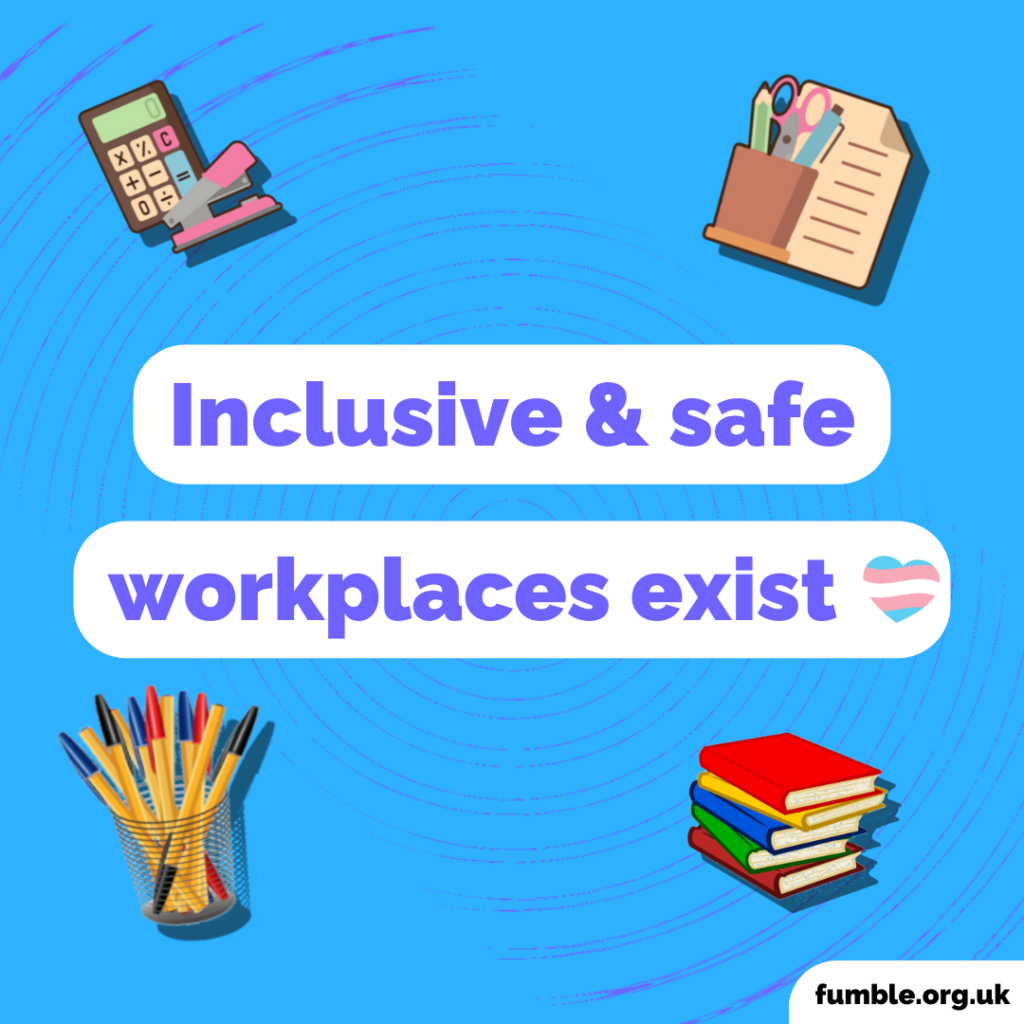Navigating being trans+ in the workplace
Coming out and being yourself in the workplace can be challenging – here are some tips on navigating this
When I started working professionally (around 4 years ago) as a musician, teacher and charity worker, I found varying degrees of acceptance of my gender and sexuality across each different workplace.
This led me to somewhat pick and choose where I could express my true self. It affected where I felt able to ask for the correct pronouns to be used: they/them. For example, when I worked in a church as a drummer I felt I couldn’t be ‘out’. But working across different arts and LGBTQIA+ charities and organisations was much easier for me.
Being in a traditionally hyper-masculine or feminine environment can be dysphoric and frustrating, especially if your workplace requires traditionally ‘masculine’ or ‘feminine’ workwear. I have found this myself, being a non-binary person in teaching and often having to wear traditionally ‘hyper-masculine’ workwear.
Being in this workplace is difficult, especially whilst trying to educate staff on gender and sexuality. I often feel like I don’t present ‘androgynous enough’ in such places, and people who are less educated on queer identities expect something different.
It often felt as though I was living a double life. I was much less confident and more reserved in unaccepting workspaces, but my usual confident, outgoing self in places I could express myself authentically. This was especially the case in a workplace where I was supporting students with disabilities and behavioural issues, and where I could see staff members’ lack of open-mindedness. This left me feeling isolated and not wanting to mix too much with certain staff members.
Additionally, being a self-employed freelancer and moving through a variety of different workspaces in a short period of time (usually only spending a day or two at each workplace) makes it difficult to educate other staff members and make sure everyone uses the correct pronouns.
A more positive note
But, on a more positive note, I have since decided to generally only accept jobs with gender-inclusive workplaces. Of course it can never be fully guaranteed that any workplace will be perfectly inclusive. But knowing an organisation is working towards equality gives me the confidence to push myself to make staff members aware of my identity and pronouns. This isn’t always easy and requires a bit of confidence. But I have found that it often creates a more positive workspace for myself, other staff members, and hopefully future staff and even students facing the same issues.
Of course trans+ people shouldn’t have to accept a reduced number of employment opportunities, so that they feel safe in their workplace. And, at the same time, I want to give you realistic advice in a society where transphobia is rife.
Inclusive and safe workplaces do exist, and you deserve to work somewhere where you feel safe to be yourself.

Tips for the workplace
Coming out in the workspace isn’t always easy to do. It often requires a lot of confidence and can be fairly anxiety provoking. But I do have a few tips for how to navigate this, if you’re feeling safe to do so:
1️⃣ Find one coworker who can be on ‘your side’. It always starts with one ally. Their acceptance and understanding can spread to other staff more quickly and easily than you might think. Which means less of those awkward or anxiety-inducing situations or conversations.
2️⃣ Find out what support is available at your workplace. If you don’t feel comfortable talking to colleagues, seek out a staff member to support you. This is someone who you can talk to about your situation and confidentially discuss how you’re feeling. It’s really important to know where/who you can turn to. This is especially important if anyone at your workplace is particularly unreceptive to your identity, or if you are facing any discrimination.
3️⃣ Go for it! As long as you feel safe and comfortable to do so (this is crucial) and you know where to get support if you need it, go ahead and make your colleagues aware of your identity. You might be surprised by how receptive your colleagues are to this conversation. Your honesty might encourage them to be more open and honest with you too.
Morgan, they/them
This article is part of our “Am I Trans?” Translating Sex, Identity & Relationships content series: supporting trans+ young people to access sex and relationships education that is relevant to their experiences and needs. Discover the full series here.
We use the term trans+ in our articles as an umbrella term intended to incorporate all transgender, non-binary, agender and genderfluid identities.
Some of the content addresses potentially triggering topics, such as transphobia and gender dysphoria. We’ve added specific content warnings to these pieces, but please take a moment to check in with yourself and how you’re feeling before diving into the series.
Other support
- Discover the full series
- Support & resources for trans+ young people
- Switchboard helpline – for anyone, anywhere in the country, at any point in their journey to discuss anything related to sexuality and gender identity
- Gendered Intelligence – Knowledge is Power resource for young trans+ people
Read more
Last Reviewed 22 April 2024
Image Credit: The Gender Spectrum Collection







